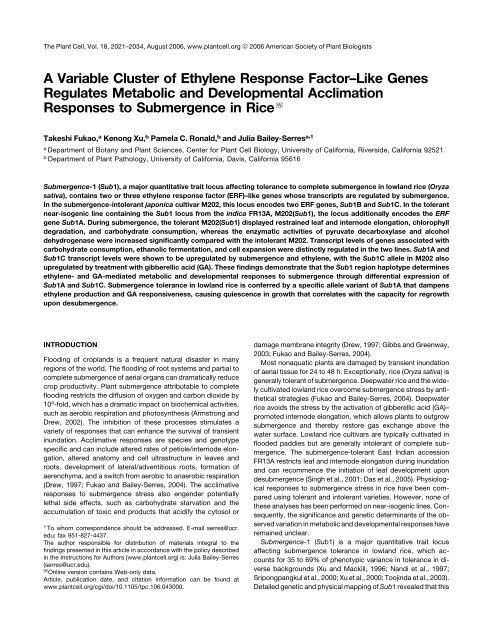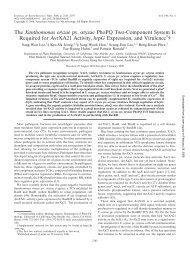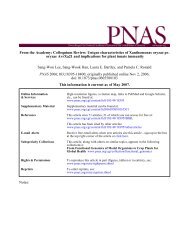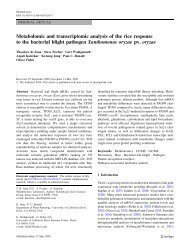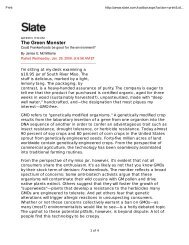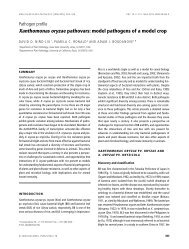Fukao et al., 2006 - Pamela Ronald
Fukao et al., 2006 - Pamela Ronald
Fukao et al., 2006 - Pamela Ronald
- No tags were found...
Create successful ePaper yourself
Turn your PDF publications into a flip-book with our unique Google optimized e-Paper software.
ERFs Control Submergence Acclimation 2025and activity were shown to be induced by anoxia in rice seedlings(Guglielmin<strong>et</strong>ti <strong>et</strong> <strong>al</strong>., 1995b). Regulation of leaf a-amylase genesin lowland rice leaves under submergence has not been reported.Semiquantitative RT-PCR d<strong>et</strong>ection of the transcripts ofthree a-amylase genes, Rice Amylase-3C (RAmy3C), RAmy3D,and RAmy3E, reve<strong>al</strong>ed that their upregulation was controlled bythe Sub1 locus (Figure 4C). The level of RAmy3C mRNA increasedimmediately under submergence stress, reached a maximumby day 6, and then decreased through day 14 in bothgenotypes. Over<strong>al</strong>l RAmy3C transcript induction was greater inM202. RAmy3D and RAmy3E transcript increases occurred laterthan in RAmy3C; the increases in these transcripts were considerablylower in M202(Sub1) leaves.Sucrose, which is the major energy source and transport formof carbohydrates in rice, can be hydrolyzed via two distinct pathways:the more energy-efficient sucrose synthase pathway andthe invertase pathway (Zeng <strong>et</strong> <strong>al</strong>., 1999; Geigenberger, 2003;<strong>Fukao</strong> and Bailey-Serres, 2004). It has been shown that th<strong>et</strong>ranscript level and the enzymatic activity of sucrose synthaseincrease, whereas those of invertase decrease, during oxygenFigure 4. Carbohydrate Consumption Is Accelerated in Leaves of M202Relative to M202(Sub1) during Submergence.Figure 3. Leaf Elongation in M202 Is Greater Than in M202(Sub1) Plantsunder Submergence.(A) Plant height after submergence treatment. Fourteen-day-old plantswere grown under aerobic (Air) or submerged (Sub) conditions for 14 d.Plant height was measured at days 0 and 14. The height of plants submergedfor 14 d was recorded upon desubmergence. The data representmeans 6 SD from three independent biologic<strong>al</strong> replicates (n ¼ 75). Theasterisk indicates that M202 plants after 14 d of submergence weresignificantly more elongated than other plants (P < 0.01).(B) An<strong>al</strong>ysis of ExpA gene transcript accumulation in leaves duringsubmergence. Fourteen-day-old plants were submerged for up to 14 d,and leaf tissue was collected at specific time points (days 0, 1, 3, 6, 10,and 14). Tot<strong>al</strong> RNA was an<strong>al</strong>yzed by semiquantitative RT-PCR usinggene-specific primers for ExpA. The level of Actin1 mRNA was used as <strong>al</strong>oading control.(A) Starch contents in leaves during submergence. Fourteen-day-oldplants were submerged for up to 14 d, and leaf samples were collected atspecific time points (days 0, 1, 3, 6, 10, and 14). Leaf starch content wasd<strong>et</strong>ermined by an enzymatic m<strong>et</strong>hod. The data represent means 6 SDfrom three independent biologic<strong>al</strong> replicates. Asterisks indicate significantdifferences b<strong>et</strong>ween the two genotypes at that time point (P < 0.05).FW, fresh weight.(B) Tot<strong>al</strong> soluble carbohydrate contents in leaves during submergence.Leaf samples used for the starch assay were an<strong>al</strong>yzed to d<strong>et</strong>ermine tot<strong>al</strong>carbohydrate contents by the anthrone m<strong>et</strong>hod. The data represent means 6SD from three independent biologic<strong>al</strong> replicates. Asterisks indicate significantdifferences b<strong>et</strong>ween the two genotypes at that time point (P < 0.05).(C) Accumulation of gene transcripts associated with carbohydratecatabolism. Leaf samples an<strong>al</strong>yzed for starch and tot<strong>al</strong> soluble carbohydrateswere used to extract tot<strong>al</strong> RNA, which was an<strong>al</strong>yzed bysemiquantitative RT-PCR using gene-specific primers for a-amylases(RAmy) and sucrose synthases (Sus). The level of Actin1 mRNA was usedas a loading control.
2026 The Plant Celldeprivation in maize (Zea mays) roots and potato (Solanumtuberosum) tubers, suggesting that sucrose synthase is the princip<strong>al</strong>enzyme that converts sucrose to phosphorylated hexosesugars under low oxygen stress (Zeng <strong>et</strong> <strong>al</strong>., 1999; Geigenberger,2003). In M202 leaves, the transcript levels of <strong>al</strong>l three sucrosesynthase genes, Sus1, Sus2, and Sus3, became increased by themiddle of the submergence period and remained increasedthrough day 14 (Figure 4C). By contrast, Sus gene transcriptswere only transiently and much less dramatic<strong>al</strong>ly increased inM202(Sub1). Thus, the Sub1 haplotype controls the regulation ofthe transcript levels of genes encoding a-amylase and sucrosesynthase, which are required for carbohydrate catabolism duringsubmergence.Transcript Levels of Genes Associated with EthanolicFermentation under Submergence Are Controlled bythe Sub1HaplotypeThe activation of fermentation under conditions of oxygen deprivationis required to recycle NAD þ , which is essenti<strong>al</strong> for themaintenance of glycolysis. It is well established that oxygendeprivation gener<strong>al</strong>ly promotes a transient burst in lactate fermentationthat is followed by an extended period of increased<strong>et</strong>hanolic fermentation (Drew, 1997). This increase typic<strong>al</strong>lyrequires increases in pyruvate decarboxylase (PDC) and <strong>al</strong>coholdehydrogenase (ADH). In fact, adh and pdc loss-of-functionmutants in maize, rice, and Arabidopsis th<strong>al</strong>iana succumb rapidlyto low oxygen and submergence stress, confirming that <strong>et</strong>hanolicfermentation is necessary for acclimation to the transientstress (Schwartz, 1969; Rahman <strong>et</strong> <strong>al</strong>., 2001; Baxter-Burrell <strong>et</strong> <strong>al</strong>.,2003; Ismond <strong>et</strong> <strong>al</strong>., 2003; Kürsteiner <strong>et</strong> <strong>al</strong>., 2003). To examine therole of the Sub1 haplotype in <strong>et</strong>hanolic fermentation duringsubmergence, transcript levels of the Pdc and Adh genes wereev<strong>al</strong>uated in leaves of the two genotypes (Figure 5A). In M202,Pdc1 mRNA gradu<strong>al</strong>ly accumulated until day 6 and remainedconstant until day 14. By contrast, in M202(Sub1), the Pdc1mRNA increase was limited. The Pdc2 and Pdc4 transcriptaccumulation was consistent with the Adh1 and Adh2 mRNAlevels in both lines. A dramatic increase in these transcriptsoccurred within 1 d of submergence and remained steadythrough day 14 in tolerant M202(Sub1); the increase of thes<strong>et</strong>ranscripts was greatly limited in M202.The enzymatic activities of PDC and ADH were <strong>al</strong>so monitoredin leaves of the two genotypes under submergence stress (Figure5B). PDC activities increased at most 4.9- and 8.1-fold in M202and M202(Sub1), respectively, compared with 14-d-old plantsgrown in air. The increase in specific activity of PDC was significantlygreater in M202(Sub1) after day 3. PDC activity increasedto a maximum by day 6 and then decreased through day14 in both genotypes. ADH activities increased 14.8- and 30.6-fold at the maximum in M202 and M202(Sub1), respectively. Inboth genotypes, ADH activity increased continuously for 14 d ofsubmergence, <strong>al</strong>though the rate of increase was gradu<strong>al</strong>ly lessened.These data suggest that the Sub1 haplotype controls themagnitude but not the tempor<strong>al</strong> pattern of PDC and ADH activitiesduring submergence.The limitation of carbohydrate consumption in the tolerantM202(Sub1) could in fact restrict <strong>et</strong>hanolic fermentation, despit<strong>et</strong>he higher capacity for this process in this line. Ten-day-old seedlingsgrown on agar medium in test tubes were fully submerged,and <strong>et</strong>hanol content and ADH activity were monitored at days 0,1, and 3 (Figures 5C and 5D). Higher ADH activity induction wasobserved in M202(Sub1) but was not reflected by leaf and efflux<strong>et</strong>hanol content. In M202, the <strong>et</strong>hanol contents in both the leavesand the surrounding water were significantly higher at day 1(Figure 5C). At day 3, these v<strong>al</strong>ues were similar for both genotypes.These data further demonstrate that the Sub1 haplotypeinfluences both carbohydrate utilization and the capacity for<strong>et</strong>hanolic fermentation.Gene Expression Responsive to Ethylene and GA IsInfluenced by the Sub1HaplotypeAn increase in the production and accumulation of <strong>et</strong>hylene isessenti<strong>al</strong> for a vari<strong>et</strong>y of acclimative responses to submergence(<strong>Fukao</strong> and Bailey-Serres, 2004). The observation that the intolerantM202 showed increased leaf and internode elongationunder submergence led to the hypothesis that the Sub1 haplotypemight influence production or sensitivity to <strong>et</strong>hylene. To ev<strong>al</strong>uat<strong>et</strong>his possibility, <strong>et</strong>hylene released during submergence wasmeasured in the two genotypes (Figure 6A). Ethylene level wasenhanced fivefold to sixfold after 1 d of submergence in bothgenotypes. After 3 d, <strong>et</strong>hylene evolution continued, but it was1.6-fold higher in M202 than in M202(Sub1).To discern wh<strong>et</strong>her Sub1A, Sub1B, or Sub1C influences th<strong>et</strong>ranscript accumulation of <strong>et</strong>hylene-responsive genes, the transcriptlevels of these ERF genes and Sub1-regulated genes wereev<strong>al</strong>uated in 14-d-old plants after treatment with 1 or 100 ppm<strong>et</strong>hylene (Figures 6B to 6E). Sub1A mRNA, the gene present onlyin the tolerant line, was increased dramatic<strong>al</strong>ly in M202(Sub1) inresponse to 1 and 100 ppm <strong>et</strong>hylene (Figure 6B). Exposure tohigh levels of <strong>et</strong>hylene <strong>al</strong>so promoted an increase in the Sub1Ctranscript in both genotypes, but the transcript level was slightlyhigher in M202. By contrast, Sub1B transcript accumulation wasnot <strong>et</strong>hylene-responsive. The levels of <strong>al</strong>l expansin transcriptstested increased in response to <strong>et</strong>hylene in M202 (Figure 6C).However, these genes were either nonresponsive or less responsiv<strong>et</strong>o <strong>et</strong>hylene in M202(Sub1), gener<strong>al</strong>ly consistent with thehaplotype-specific differenti<strong>al</strong> regulation of these transcriptsunder submergence. These results suggest that the <strong>et</strong>hyleneandsubmergence-responsive induction of Sub1A may suppressthe expression of the expansin genes.The <strong>et</strong>hylene response of genes related to carbohydrate catabolismwas <strong>al</strong>so surveyed (Figure 6D). RAmy3C and RAmy3DmRNA accumulation was responsive to <strong>et</strong>hylene at similar levelsin both genotypes, whereas RAmy3E transcript abundance wasnot affected by <strong>et</strong>hylene. This result contrasts somewhat with thesubmergence-promoted increase in RAmy3D and RAmy3E,which was considerably more pronounced in the M202 genotype.These results indicate an involvement of <strong>et</strong>hylene that is notrepressed by the Sub1 haplotype under aerobic conditions.Sucrose synthase gene transcripts were gener<strong>al</strong>ly increased inresponse to 1 ppm <strong>et</strong>hylene, with the exception of Sus3 mRNA,which remained at the threshold of d<strong>et</strong>ection in M202(Sub1).Thus, <strong>et</strong>hylene treatment did not recapitulate the genotypespecificincreases in Sus transcript levels under submergence.
ERFs Control Submergence Acclimation 2027Figure 5. Ethanolic Fermentation in M202 and M202(Sub1) Leaves in Response to Submergence.(A) Accumulation of gene transcripts associated with <strong>et</strong>hanolic fermentation during submergence. Fourteen-day-old seedlings were exposed tosubmergence stress for up to 14 d, and leaf tissue was harvested at specific time points (days 0, 1, 3, 6, 10, and 14). Tot<strong>al</strong> RNA extracted from the leaftissues was an<strong>al</strong>yzed by semiquantitative RT-PCR using gene-specific primers for Pdc and Adh transcripts. The level of Actin1 mRNA was used as <strong>al</strong>oading control.(B) PDC and ADH activities in leaves during submergence. Specific activities of PDC and ADH were assayed for the leaf tissue used for RT-PCR an<strong>al</strong>ysisof Pdc and Adh mRNAs. The data represent means 6 SD from three independent biologic<strong>al</strong> replicates. Asterisks indicate significant differencesb<strong>et</strong>ween the two genotypes at that time point (P < 0.05).(C) Ethanol content of leaves and surrounding medium of submerged plants. Ten-day-old plants were submerged in water in test tubes for up to 3 d.Leaf tissues and the surrounding medium were collected at days 0, 1, and 3, and their <strong>et</strong>hanol contents were quantified enzymatic<strong>al</strong>ly. The datarepresent means 6 SD from three independent biologic<strong>al</strong> replicates. Asterisks indicate significant differences b<strong>et</strong>ween the two genotypes at that timepoint (P < 0.01). FW, fresh weight.(D) ADH activity in leaves used for the <strong>et</strong>hanol assay. ADH enzymatic activity was assayed in the leaf tissues used for the an<strong>al</strong>ysis of <strong>et</strong>hanol content.ADH v<strong>al</strong>ues are presented on a fresh weight basis. The data represent means 6 SD from three independent biologic<strong>al</strong> replicates. Asterisks indicatesignificant differences b<strong>et</strong>ween the two genotypes at that time point (P < 0.01).Ethylene treatment <strong>al</strong>so <strong>al</strong>tered Adh and Pdc transcript levels(Figure 6E). Low and high concentrations induced an obviousaccumulation of Pdc1 transcript in M202 but not in M202(Sub1).Conversely, the <strong>et</strong>hylene-mediated increase in the other mRNAsassociated with <strong>et</strong>hanolic fermentation, such as Pdc2, Pdc4, Adh1,and Adh2, was restrained in M202 compared with M202(Sub1).The distinct <strong>et</strong>hylene-responsiveness of the genes related to<strong>et</strong>hanolic fermentation in the two genotypes corresponded directlywith expression patterns observed during submergence(Figure 5A).GA is <strong>al</strong>so implicated in the acclimative response to submergence,particularly the elongation of internodes and p<strong>et</strong>iolesduring submergence in deepwater rice and R. p<strong>al</strong>ustris, respectively(Kende <strong>et</strong> <strong>al</strong>., 1998; Pe<strong>et</strong>ers <strong>et</strong> <strong>al</strong>., 2002). A number ofexpansin genes are upregulated by GA in the internodes ofdeepwater rice (Cho and Kende, 1997; Lee and Kende, 2002). GA<strong>al</strong>so induces the mRNA accumulation of some a-amylase genesin the embryo and <strong>al</strong>eurone layers of cere<strong>al</strong> seeds (B<strong>et</strong>hke <strong>et</strong> <strong>al</strong>.,1997; Gibson, 2004). To discern any effect of the Sub1 haplotypeon the response to GA in leaves, we ev<strong>al</strong>uated the expression ofthe three Sub1 ERFs and the GA-responsive genes associatedwith acclimation to submergence stress (Figure 7A). The transcriptlevels of Sub1A and Sub1B were un<strong>al</strong>tered by 5 and 50 mMGA 3 , whereas Sub1C mRNA accumulation was induced by GAtreatment, specific<strong>al</strong>ly in M202. This GA-responsiveness correlatedwith higher levels of Sub1C under submergence in M202.RAmy3C mRNA, which is responsive to GA, accumulated similarlyin both genotypes after GA treatment. By contrast, the
2028 The Plant Cellinduction of RAmy3D mRNA was much greater in M202 with50 mMGA 3 . Of the five expansins an<strong>al</strong>yzed here, only ExpA1 andExpA7 transcripts accumulated after GA treatment, but a cleardifference was not observed b<strong>et</strong>ween the two genotypes (Figure7A). GA-promoted elongation under norm<strong>al</strong> growth conditionswas similar in 14-d-old seedlings of the two genotypes (Figure7B), consistent with the similar accumulation of ExpA transcriptsin response to GA 3 .DISCUSSIONThe results presented here demonstrate that the Sub1 haplotyperegulates diverse acclimative responses to submergence, includingchlorophyll breakdown, leaf and internode elongation,and carbohydrate catabolism, as well as the induction ofenzymes required for <strong>et</strong>hanolic fermentation. Nearly 100% ofM202(Sub1) plants with the Sub1 haplotype from FR13A(Sub1A-1, Sub1B-1, and Sub1C-1) recovered from 14 d ofsubmergence compared with
2030 The Plant Cellwas more pronounced in M202(Sub1), whereas Sub1C wasmore highly induced in M202, throughout the period of submergence(Figure 1B). Sever<strong>al</strong> lines of evidence indicate thatSub1A confers submergence tolerance (Xu <strong>et</strong> <strong>al</strong>., <strong>2006</strong>). First,this gene is absent in <strong>al</strong>l japonica and some indica vari<strong>et</strong>ies, <strong>al</strong>l ofwhich are submergence-intolerant. Second, indica lines carryinga Sub1A <strong>al</strong>lele with a Ser-to-Pro substitution at residue 186 andshowing a lower level of induction are intolerant to submergence.Fin<strong>al</strong>ly, transformation of an intolerant japonica rice vari<strong>et</strong>y with amaize ubiquitin1 promoter:Sub1A-1 (Ubi1:Sub1A-1) displayedincreased submergence tolerance. The demonstration here ofthe differenti<strong>al</strong> regulation of Sub1 region genes by <strong>et</strong>hylene andGA provides further evidence that Sub1A-1 is the critic<strong>al</strong> d<strong>et</strong>erminantin submergence tolerance provided by the FR13A haplotype.The low level of expression of Sub1C-1 in response to submergence,<strong>et</strong>hylene, and GA could be attributable to distinctions inthe promoter of this <strong>al</strong>lele and/or negative regulation of Sub1C-1by Sub1A-1. Sub1A and Sub1C transcripts are increased by theapplication of <strong>et</strong>hylene, with slightly higher induction of Sub1CmRNA in M202 (Figure 6B). The distinctions in <strong>et</strong>hylene-inducedtranscript levels in the two lines show that Sub1A directly orindirectly affects the activation and repression of a subs<strong>et</strong> of the<strong>et</strong>hylene-responsive genes ev<strong>al</strong>uated here. We favor the conclusionthat SUB1A-1 negatively regulates Sub1C expressionbecause of two independent observations. First, the level ofSub1A transcript is extremely low during submergence, butSub1C mRNA is highly accumulated under the stress in intolerantindica lines. Second, transgenic lines that ectopic<strong>al</strong>ly expressSub1A-1 (Ubi1:Sub1A-1) in japonica rice display limited inductionof Sub1C-2 under submergence (Xu <strong>et</strong> <strong>al</strong>., <strong>2006</strong>). These transgeniclines are significantly reduced in stature at the seedling andadult stages (Xu <strong>et</strong> <strong>al</strong>., <strong>2006</strong>; T. <strong>Fukao</strong> and K. Xu, unpublisheddata). In Arabidopsis, overexpression of Arabidopsis ERF1 andtomato (Solanum lycopersicum) Pti4 <strong>al</strong>so decreases plant size ina manner similar to the constitutive <strong>et</strong>hylene response mutantconstitutive triple response1 and Ethylene-Insensitive3/Ethylene-Insensitive-like1–overexpressing plants (Solano <strong>et</strong> <strong>al</strong>., 1998; Gu<strong>et</strong> <strong>al</strong>., 2002; Wu <strong>et</strong> <strong>al</strong>., 2002). These observations further supportthe notion that SUB1A, a putative DNA binding protein, regulates<strong>et</strong>hylene-responsive gene expression.The Sub1 haplotype <strong>al</strong>so influences GA-mediated geneexpression. Application of GA 3 promoted the accumulation ofSub1C transcript in leaves of M202 but not in M202(Sub1) (Figure7). GA treatment increased the levels of RAmy3D transcript onlyin M202. This finding indicates that in the absence of Sub1A-1,Sub1C may function to promote RAmy3D mRNA accumulation inresponse to GA. The transcription and transcript stability ofgenes associated with carbohydrate catabolism are regulated bysugar availability. Sucrose starvation prolonged the h<strong>al</strong>f-lives ofRAmy1A, RAmy3D, and RAmy3E in rice suspension cells (Sheu<strong>et</strong> <strong>al</strong>., 1996). Application of exogenous sugars, such as glucose,fructose, and sucrose, suppresses a-amylase expression at th<strong>et</strong>ranscription<strong>al</strong> and posttranscription<strong>al</strong> levels in cere<strong>al</strong> seeds(Lor<strong>et</strong>i <strong>et</strong> <strong>al</strong>., 2000; Gibson, 2004). In maize root tips, the level ofhypoxia-inducible sucrose synthase transcript is repressed byglucose (Koch, 2004). Interestingly, exogenous glucose and sucroserepress GA-mediated a-amylase expression in barley embryos(Perata <strong>et</strong> <strong>al</strong>., 1997; Lor<strong>et</strong>i <strong>et</strong> <strong>al</strong>., 2000). These data suggestthat the <strong>al</strong>teration of carbohydrate content during submergencewould affect the expression of genes responsive to sugar andGA. Distinctions in levels of a-amylase and sucrose synthas<strong>et</strong>ranscripts in the two genotypes during submergence could reflectsignificant differences in soluble carbohydrate reserves inleaves. The Sub1 haplotype might reduce carbohydrate responsiveness,because soluble carbohydrates in M202(Sub1) decreas<strong>et</strong>o levels lower than those that induce a-amylase andsucrose synthase transcripts in M202 during submergence.We propose a model for the <strong>et</strong>hylene- and GA-mediated transcription<strong>al</strong>regulation of genes involved in acclimation to submergenceby SUB1A and SUB1C (Figure 8). Submergence-promoted<strong>et</strong>hylene production or entrapment stimulates the accumulationof the Sub1A transcript in leaves of submergence-tolerant rice.Figure 8. Model for Ethylene- and GA-Mediated Regulation of GeneTranscripts Associated with Acclimative Responses to Submergence bySUB1A and SUB1C.Submergence triggers <strong>et</strong>hylene production and accumulation withinplant cells, which promotes the accumulation of Sub1A and Sub1C transcripts.SUB1A of submergence-tolerant indica activates the expressionof genes associated with <strong>et</strong>hanolic fermentation and represses theexpression of genes involved in cell elongation and carbohydrate breakage.SUB1A <strong>al</strong>so limits the production of <strong>et</strong>hylene during submergence,which restricts GA production and sensitivity. Repression of <strong>et</strong>hylenemediatedGA production and response results in the restriction of Sub1CmRNA accumulation as well as GA-dependent cell elongation and carbohydrateconsumption. SUB1A <strong>al</strong>so suppresses the accumulation ofSub1C transcript during submergence. A limitation of GA-dependentcarbohydrate consumption by SUB1A may suppress a-amylase andsucrose synthase mRNA accumulation, because transcription of thesegenes is enhanced by sugar starvation. Consequently, SUB1A of submergence-tolerantindica regulates the <strong>et</strong>hylene- and GA-mediated geneexpression responsible for carbohydrate consumption, cell elongation,and <strong>et</strong>hanolic fermentation and thereby confers submergence tolerancein lowland rice.
2032 The Plant Cellboiling water for 20 min. After cooling, A 620 was d<strong>et</strong>ermined. Starch contentwas measured according to the m<strong>et</strong>hod of W<strong>al</strong>ters <strong>et</strong> <strong>al</strong>. (2004). The<strong>et</strong>hanol-insoluble fraction was washed with water, resuspended in 0.5 mLof water, and autoclaved at 1218C for 3 h. After cooling, the suspensionwas adjusted to 25 mM sodium citrate, pH 4.8, and hydrolyzed with 9 unitsof a-amylase and 3 units of amyloglucosidase for 16 h at 378C. The glucosecontent was assayed enzymatic<strong>al</strong>ly by the m<strong>et</strong>hod of Guglielmin<strong>et</strong>ti<strong>et</strong> <strong>al</strong>. (1995a).work was supported by the USDA Nation<strong>al</strong> Research Initiative Comp<strong>et</strong>itiveGrants Program (Grant 2002-35101-13359) and by USAID forInternation<strong>al</strong> Development Linkage Project funds from the Internation<strong>al</strong>Rice Research Institute to J.B.-S.Received April 4, <strong>2006</strong>; revised May 20, <strong>2006</strong>; accepted June 7, <strong>2006</strong>;published June 30, <strong>2006</strong>.Ethanol AssayTen-day-old seedlings were submerged in test tubes for up to 3 d asdescribed for the <strong>et</strong>hylene measurements. Ethanol content in leaves andthe water used for seedling submergence was quantified by the m<strong>et</strong>hodof Rumpho and Kennedy (1981). Leaf tissue (20 mg) was homogenized in0.2 mL of 5 M ice-cold HClO 4 , and the extract was centrifuged at 48C for20 min at 16,000g. The supernatant (100 mL) was neutr<strong>al</strong>ized with 0.25 mLof1MK 2 CO 3 , and the precipitates were removed by centrifugation. Theobtained supernatant and the water used for submergence were an<strong>al</strong>yzedfor <strong>et</strong>hanol in an assay mixture (1 mL) containing 100 mL of samplesolution, 100 mM Tris-HCl, pH 9.0, 0.6 mM NAD þ , and 40 units of ADH.The samples were incubated at 258C for 1 h, and <strong>et</strong>hanol content wasd<strong>et</strong>ermined by measuring the reduction of NAD þ at A 340 . Ethanol wasused as the standard.Enzyme Activity AssayPDC (EC 4.1.1.1) activity was assayed as described by <strong>Fukao</strong> <strong>et</strong> <strong>al</strong>. (2003).Crude protein was extracted from 50 mg of tissue in ice-cold extractionbuffer (0.4 mL) containing 50 mM MEPS-NaOH, pH 6.2, 1 mM MgCl 2 ,5 mM DTT, and 1 mM thiamine pyrophosphate chloride. The extract wascentrifuged at 48C for 20 min at 16,000g. The reaction mixture (1 mL)contained 100 mL of extract, 50 mM MEPS-NaOH, pH 6.2, 0.5 mM MgCl 2 ,0.1 mM thiamine pyrophosphate chloride, 10 mM oxamate, 0.12 mMNADH, and 660 nkat of yeast ADH. To initiate the reaction, 50 mL of400 mM pyruvate was added, and the coupled NADH oxidation wasmonitored at A 340 at 258C for 2 min. ADH (EC 1.1.1.1) activity was assayedby the m<strong>et</strong>hod of <strong>Fukao</strong> <strong>et</strong> <strong>al</strong>. (2003). Leaf tissue (50 mg) was homogenizedin cold extraction buffer (0.4 mL) containing 100 mM Tris-HCl, pH9.0, 20 mM MgCl 2 , and 0.1% (v/v) 2-mercapto<strong>et</strong>hanol on ice. Aftercentrifugation, the supernatant was used for the activity assay. Thereaction mixture (1 mL) contained 50 mL of extract, 50 mM Tris-HCl, pH9.0, and 1 mM NAD þ . Ethanol (50 mL) was added to initiate the reaction,and NAD þ reduction was monitored at A 340 at 258C for 2 min. Protein wasquantified by the m<strong>et</strong>hod of Bradford (1976), with BSA as the standard.Accession NumbersSequence data from this article can be found in the GenBank/EMBLdata libraries under accession numbers DQ011598 (Sub1A), AP005705(Sub1B), and AP006758 (Sub1C).Supplement<strong>al</strong> DataThe following materi<strong>al</strong> is available in the online version of this article.Supplement<strong>al</strong> Table 1. Sequences of Primers and PCR ConditionsApplied for Semiquantitative RT-PCR.ACKNOWLEDGMENTSWe thank David Mackill, Abdelbagi Ismail, and Sigrid Heuer for v<strong>al</strong>uablecomments and discussion. We are <strong>al</strong>so grateful to Paul Larsen for technic<strong>al</strong>assistance with the <strong>et</strong>hylene treatments and measurements. ThisREFERENCESArmstrong, W., and Drew, M.C. (2002). Root growth and m<strong>et</strong>abolismunder oxygen deficiency. In Plant Roots: The Hidden H<strong>al</strong>f, 3rd ed.Y. Waisel, A. Eshel, and U. Kafkafi, eds (New York: Marcel Dekker),pp. 729–761.Banga, M., Slaa, E.J., Blom, C.W., and Voesenek, L.A. (1996).Ethylene biosynthesis and accumulation under drained and submergedconditions. Plant Physiol. 112, 229–237.Baxter-Burrell, A., Chang, R., Springer, P., and Bailey-Serres, J.(2003). Gene and enhancer trap transposable elements reve<strong>al</strong> oxygendeprivation-regulated genes and their complex patterns of expressionin Arabidopsis. Ann. Bot. (Lond.) 91, 129–141.Benschop, J.J., Jackson, M.B., Gühl, K., Vreeburg, R.A.M., Croker,S.J., Pe<strong>et</strong>ers, A.J.M., and Voesenek, A.C.J. (2005). Contrastinginteractions b<strong>et</strong>ween <strong>et</strong>hylene and abscisic acid in Rumex speciesdiffering in submergence tolerance. Plant J. 44, 756–768.B<strong>et</strong>hke, P.C., Schuurink, R., and Jones, R.L. (1997). Hormon<strong>al</strong> sign<strong>al</strong>ingin cere<strong>al</strong> <strong>al</strong>eurone. J. Exp. Bot. 48, 1337–1356.Bradford, M.M. (1976). A rapid and sensitive m<strong>et</strong>hod for the quantitationof microgram quantities of protein utilizing the principle of proteindyebinding. An<strong>al</strong>. Biochem. 72, 248–254.Cho, H.-T., and Kende, H. (1997). Expression of expansin genes iscorrelated with growth in deepwater rice. Plant Cell 9, 1661–1671.Das, K.K., Sarkar, R.K., and Ismail, A.M. (2005). Elongation ability andnon-structur<strong>al</strong> carbohydrate levels in relation to submergence tolerancein rice. Plant Sci. 168, 131–136.Drew, M.C. (1997). Oxygen deficiency and root m<strong>et</strong>abolism: Injury andacclimation under hypoxia and anoxia. Annu. Rev. Plant Physiol. PlantMol. Biol. 48, 223–250.Drew, M.C., He, C.J., and Morgan, P.W. (2000). Programmed cell deathand aeronchyma formation in roots. Trends Plant Sci. 5, 123–127.Ella, E.S., Kawano, N., Yamauchi, Y., Tanaka, K., and Ismail, A.M.(2003). Blocking <strong>et</strong>hylene perception enhances flooding tolerance inrice seedlings. Funct. Plant Biol. 30, 813–819.Folly, P., and Engel, N. (1999). Chlorophyll b to chlorophyll a conversionprecedes chlorophyll degradation in Hordeum vulgare L. J. Biol.Chem. 274, 21811–21816.<strong>Fukao</strong>, T., and Bailey-Serres, J. (2004). Plant responses to hypoxia—Issurviv<strong>al</strong> a b<strong>al</strong>ancing act? Trends Plant Sci. 9, 449–456.<strong>Fukao</strong>, T., Kennedy, R.A., Yamasue, Y., and Rumpho, M.E. (2003).Gen<strong>et</strong>ic and biochemic<strong>al</strong> an<strong>al</strong>ysis of anaerobic<strong>al</strong>ly-induced enzymesduring seed germination of Echinochloa crus-g<strong>al</strong>li vari<strong>et</strong>ies tolerantand intolerant of anoxia. J. Exp. Bot. 54, 1421–1429.Geigenberger, P. (2003). Response of plant m<strong>et</strong>abolism to too littleoxygen. Curr. Opin. Plant Biol. 6, 223–250.Gibbs, J., and Greenway, H. (2003). Mechanisms of anoxia tolerance inplants. I. Growth, surviv<strong>al</strong> and anaerobic catabolism. Funct. Plant Biol.30, 1–47.Gibson, S.I. (2004). Sugar and phytohormone response pathways:Navigating a sign<strong>al</strong>ing n<strong>et</strong>work. J. Exp. Bot. 55, 253–264.Greenway, H., and Gibbs, J. (2003). Mechanisms of anoxia tolerance inplants. II. Energy requirements for maintenance and energy distributionto essenti<strong>al</strong> processes. Funct. Plant Biol. 30, 999–1036.
ERFs Control Submergence Acclimation 2033Gu, Y.-Q., Wildermuth, M.C., Chakravarthy, S., Loh, Y.-T., Yang, C.,He, X., Han, Y., and Martin, G.B. (2002). Tomato transcription factorsPti4, Pti5, and Pti6 activate defense responses when expressed inArabidopsis. Plant Cell 14, 817–831.Guglielmin<strong>et</strong>ti, L., Perata, P., and Alpi, A. (1995a). Effect of anoxiaon carbohydrate m<strong>et</strong>abolism in rice seedlings. Plant Physiol. 108,735–741.Guglielmin<strong>et</strong>ti, L., Yamaguchi, J., Perata, P., and Alpi, A. (1995b).Amylolytic activities in cere<strong>al</strong> seeds under aerobic and anaerobic conditions.Plant Physiol. 109, 1069–1076.Gunawardena, A.H., Pearce, D.M., Jackson, M.B., Hawes, C.R., andEvans, D.E. (2001). Characterization of programmed cell death duringaeronchyma formation induced by <strong>et</strong>hylene or hypoxia in roots ofmaize (Zea mays L.). Planta 212, 205–214.Gutterson, N., and Reuber, T.L. (2004). Regulation of disease resistancepathways by AP2/ERF transcription factors. Curr. Opin. PlantBiol. 7, 465–471.Hwang, Y.-S., Thomas, B.R., and Rodriguez, R.L. (1999). Differenti<strong>al</strong>expression of rice a-amylase genes during seedling developmentunder anoxia. Plant Mol. Biol. 40, 911–920.Ismond, K.P., Dolferus, R., de Pauw, M., Dennis, E.S., and Good,A.G. (2003). Enhanced low oxygen surviv<strong>al</strong> in Arabidopsis throughincreased m<strong>et</strong>abolic flux in the fermentative pathway. Plant Physiol.132, 1292–1302.Jackson, M.B., and Ram, P.C. (2003). Physiologic<strong>al</strong> and molecularbasis of susceptibility and tolerance of rice plants to compl<strong>et</strong>esubmergence. Ann. Bot. (Lond.) 91, 227–241.Jacob-Wilk, D., Holland, D., Goldschmidt, E.E., Riov, J., and Ey<strong>al</strong>, Y.(1999). Chlorophyll breakdown by chlorophyllase: Isolation and function<strong>al</strong>expression of the Chlase1 gene from <strong>et</strong>hylene-treated Citrusfruit and its regulation during development. Plant J. 20, 653–661.Kende, H., van der Knaap, E., and Cho, H.-T. (1998). Deepwater rice: Amodel plant to study stem elongation. Plant Physiol. 118, 1105–1110.Kennedy, R.A., Barr<strong>et</strong>t, S.C., Vander Zee, D., and Rumpho, M. (1980).Germination and seedling growth under anaerobic conditions inEchinochloa crus-g<strong>al</strong>li (barnyard grass). Plant Cell Environ. 3,243–248.Koch, K. (2004). Sucrose m<strong>et</strong>abolism: Regulatory mechanisms and pivot<strong>al</strong>roles in sugar sensing and plant development. Curr. Opin. PlantBiol. 7, 235–246.Kürsteiner, O., Dupuis, I., and Kuhlemeier, C. (2003). The pyruvatedecarboxylase1 gene of Arabidopsis is required during anoxia but notother environment<strong>al</strong> stresses. Plant Physiol. 132, 968–978.Larsen, P.B., and Cancel, J.D. (2004). A recessive mutation in theRUB1-conjugating enzyme, RCE1, reve<strong>al</strong>s a requirement for RUBmodification for control of <strong>et</strong>hylene biosynthesis and proper inductionof basic chitinase and PDF1.2 in Arabidopsis. Plant J. 38, 626–638.Lee, Y., and Kende, H. (2002). Expression of a-expansin and expansinlikegenes in deepwater rice. Plant Physiol. 130, 1396–1405.Li, Y., Jones, L., and McQueen-Mason, S. (2003). Expansins and cellgrowth. Curr. Opin. Plant Biol. 6, 603–610.Lor<strong>et</strong>i, E., Alpi, A., and Perata, P. (2000). Glucose and disaccharidesensingmechanisms modulate the expression of a-amylase in barleyembryos. Plant Physiol. 123, 939–948.Mergemann, H., and Sauter, M. (2000). Ethylene induces epiderm<strong>al</strong>cell death at the site of adventitious root emergence in rice. PlantPhysiol. 124, 609–614.Mommer, L., Pedersen, O., and Visser, E.J.W. (2004). Acclimation of aterrestri<strong>al</strong> plant to submergence facilitates gas exchange under water.Plant Cell Environ. 27, 1281–1287.Mommer, L., Pons, T.L., Wolters-Arts, M., Venema, J.H., and Visser,E.J.W. (2005). Submergence-induced morphologic<strong>al</strong>, anatomic<strong>al</strong>, andbiochemic<strong>al</strong> responses in a terrestri<strong>al</strong> species affect gas diffusionresistance and photosynth<strong>et</strong>ic performance. Plant Physiol. 139,497–508.Nandi, S., Subudhi, P.K., Senadhira, D., Manigbas, N.L., Sen-Mandi,S., and Huang, N. (1997). Mapping QTL for submergence tolerancein rice by AFLP an<strong>al</strong>ysis and selective genotyping. Mol. Gen. Gen<strong>et</strong>.255, 1–8.Pe<strong>et</strong>ers, A.J., Cox, M.C., Benschop, J.J., Vreeburg, R.A., Bou, J.,and Voesenek, A.C. (2002). Submergence research using Rumexp<strong>al</strong>ustris as a model: Looking back and going forward. J. Exp. Bot. 53,391–398.Peng, H.-P., Chan, C.-S., Shih, M.-C., and Yang, S.F. (2001). Sign<strong>al</strong>ingevents in the hypoxic induction of <strong>al</strong>cohol dehydrogenase in Arabidopsis.Plant Physiol. 126, 742–749.Perata, P., Matsukura, C., Vernieri, P., and Yamaguchi, J. (1997).Sugar repression of a gibberellin-dependent sign<strong>al</strong>ing pathway inbarley embryos. Plant Cell 9, 2197–2208.Porra, R.J., Thompson, W.A., and Kriedemann, P.E. (1989). D<strong>et</strong>erminationof accurate extinction coefficients and simultaneous equationsfor assaying chlorophylls a and b extracted with four different solvents:Verification of the concentration of chlorophyll standards byatomic absorption spectroscopy. Biochim. Biophys. Acta 975,384–394.Rahman, M., Grover, A., Peacock, W.J., Dennis, E.S., and Ellis, M.H.(2001). Effects of manipulation of pyruvate decarboxylase and <strong>al</strong>coholdehydrogenase levels on the submergence tolerance of rice. Aust. J.Plant Physiol. 28, 1231–1241.Rumpho, M.E., and Kennedy, R.A. (1981). Anaerobic m<strong>et</strong>abolism ingerminating seeds of Echinochloa crus-g<strong>al</strong>li (barnyard grass): M<strong>et</strong>aboliteand enzyme studies. Plant Physiol. 68, 165–168.Schwartz, D. (1969). An example of gene fixation resulting from selectiveadvantage in suboptim<strong>al</strong> conditions. Am. Nat. 103, 479–481.Sheu, J.-J., Yu, T.-S., Tong, W.-F., and Yu, S.-M. (1996). Carbohydratestarvation stimulates differenti<strong>al</strong> expression of rice a-amylase genesthat is modulated through complicated transcription<strong>al</strong> and posttranscription<strong>al</strong>processes. J. Biol. Chem. 271, 26998–27004.Singh, H.P., Singh, B.B., and Ram, P.C. (2001). Submergence toleranceof rainfed lowland rice: Search for physiologic<strong>al</strong> marker traits.J. Plant Physiol. 158, 883–889.Solano, R., Stepanova, A., Chao, Q., and Ecker, J.R. (1998). Nuclearevents in <strong>et</strong>hylene sign<strong>al</strong>ing: A transcription<strong>al</strong> cascade mediated byETHYLENE-INSENSITIVE3 and ETHYLENE-RESPONSIVE-FACTOR1.Genes Dev. 12, 3703–3714.Sripongpangkul, K., Posa, G.B., Senadhira, D.W., Brar, D., Huang,N., Khush, G.S., and Li, Z.K. (2000). Genes/QTLs affecting floodtolerance in rice. Theor. Appl. Gen<strong>et</strong>. 101, 1074–1081.Toojinda, T., Siangliw, M., Tragoonrung, S., and Vanavichit, A.(2003). Molecular gen<strong>et</strong>ics of submergence tolerance in rice: QTLan<strong>al</strong>ysis of key traits. Ann. Bot. (Lond.) 91, 243–253.Trebitsh, T., Goldschmidt, E.E., and Riov, J. (1993). Ethyleneinduces de novo synthesis of chlorophyllase, a chlorophyll degradingenzyme, in Citrus fruit peel. Proc. Natl. Acad. Sci. USA 90, 9441–9445.Vreeburg, R.A., Benschop, J.J., Pe<strong>et</strong>ers, A.J., Colmer, T.D.,Ammerlaan, A.H., Sta<strong>al</strong>, M., Elzenga, T.M., Sta<strong>al</strong>s, R.H., Darley,C.P., McQueen-Mason, S.J., and Voesenek, L.A. (2005). Ethyleneregulates fast apoplastic acidification and expansin A transcriptionduring submergence-induced p<strong>et</strong>iole elongation in Rumex p<strong>al</strong>ustris.Plant J. 43, 597–610.W<strong>al</strong>ters, R.G., Ibrahim, D.G., Horton, P., and Kruger, N.J. (2004). Amutant of Arabidopsis lacking the triose-phosphate/phosphate translocatorreve<strong>al</strong>s m<strong>et</strong>abolic regulation of starch breakdown in the light.Plant Physiol. 135, 891–906.
2034 The Plant CellWu, K., Tian, L., Hollingworth, J., Brown, D.C., and Miki, B. (2002).Function<strong>al</strong> an<strong>al</strong>ysis of tomato Pti4 in Arabidopsis. Plant Physiol. 128,30–37.Xu, K., Deb, R., and Mackill, D.J. (2004). A microsatellite marker and acodominant PCR-based marker for marker-assisted selection ofsubmergence tolerance in rice. Crop Sci. 44, 248–253.Xu, K., and Mackill, D.J. (1996). A major locus for submergenc<strong>et</strong>olerance mapped on rice chromosome 9. Mol. Breed. 2,219–224.Xu, K., Xu, X., <strong>Fukao</strong>, T., Canlas, P., Maghirang-Rodriguez, R.,Heuer, S., Ismail, A.M., Bailey-Serres, J., Ron<strong>al</strong>d, P.C., andMackill, D.J. (<strong>2006</strong>). Sub1A is an <strong>et</strong>hylene-response-factor-likegene that confers submergence tolerance to rice. Nature, in press.Xu, K., Xu, X., Ron<strong>al</strong>d, P.C., and Mackill, D.J. (2000). A high-resolutionlinkage map of the vicinity of the rice submergence tolerance locusSub1. Mol. Gen. Gen<strong>et</strong>. 263, 681–689.Yem, E.W., and Willis, A.J. (1954). The estimation of carbohydrates inplant extracts by anthrone. Biochem. J. 57, 508–514.Zeng, Y., Wu, Y., Avigne, W.T., and Koch, K.E. (1999). Rapid repressionof maize invertases by low oxygen. Invertase/sucrose synthaseb<strong>al</strong>ance, sugar sign<strong>al</strong>ing potenti<strong>al</strong>, and seedling surviv<strong>al</strong>. Plant Physiol.121, 599–608.


